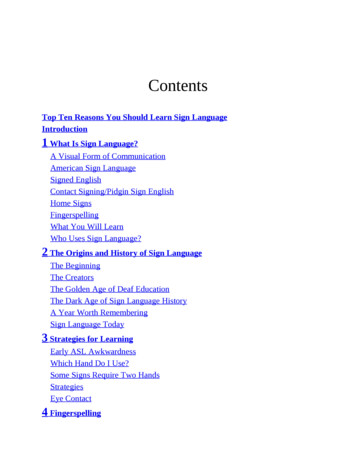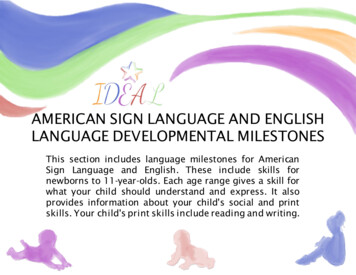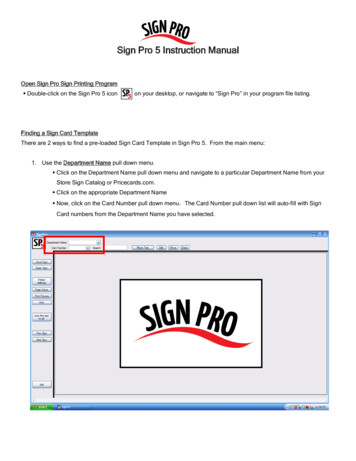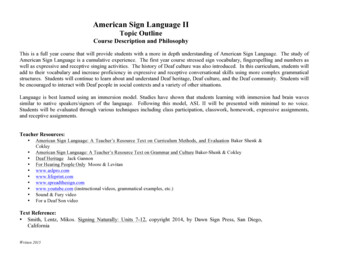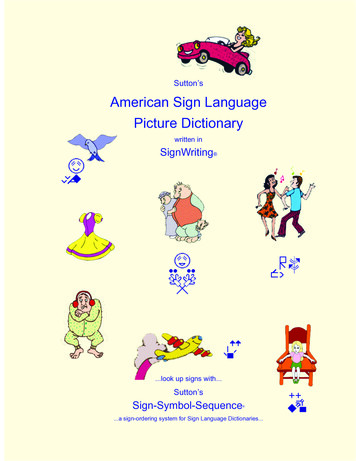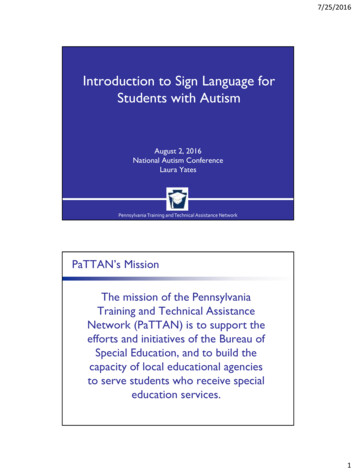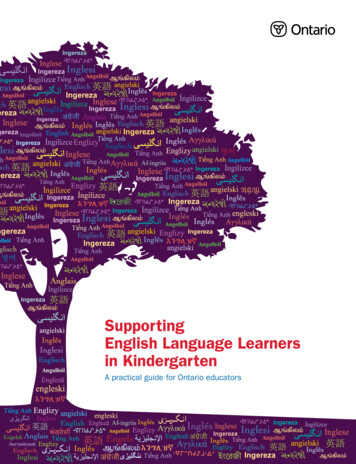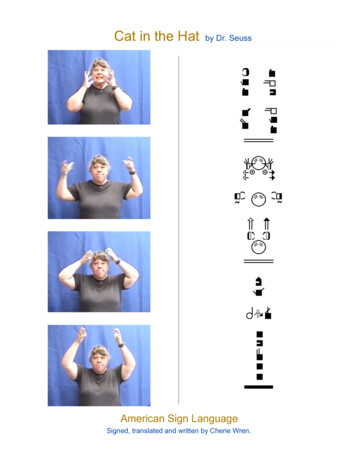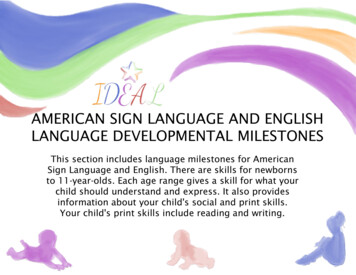
Transcription
AMERICAN SIGN LANGUAGE AND ENGLISHLANGUAGE DEVELOPMENTAL MILESTONESThis section includes language milestones for AmericanSign Language and English. There are skills for newbornsto 11-year-olds. Each age range gives a skill for what yourchild should understand and express. It also providesinformation about your child's social and print skills.Your child's print skills include reading and writing.
Table of ContentsIntroductionM-336-42 mos. receptive and expressive language skillsM-220-3 mos. receptive and expressive language skillsM-436-42 months social and print skillsM-230-3 months social and print skillsM-542-48 mos. receptive and expressive language skillsM-243-6 mos. receptive and expressive language skillsM-642-48 months social and print skillsM-253-6 months social and print skillsM-74-5 yrs. receptive and expressive language skillsM-266-9 mos. receptive and expressive language skillsM-84-5 years social and print skillsM-276-9 months social and print skillsM-95-6 yrs. receptive and expressive languageskills5-6 years social and print skillsM-286-7 yrs. receptive and expressive languageskills6-7 years social and print skillsM-307-8 yrs. receptive and expressive languageskills7-8 years social and print skillsM-32M-34M-35M-369-12 mos. receptive and expressive language skillsM-109-12 months social and print skillsM-1112-15 mos. receptive and expressive language skillsM-1212-15 months social and print skillsM-1315-18 mos. receptive and expressive language skillsM-1415-18 months social and print skillsM-1518-24 mos. receptive and expressive language skillsM-168-9 yrs. receptive and expressive languageskills8-9 years social and print skills18-24 months social and print skillsM-179-10 yrs. receptive and expressive language skills24-30 mos. receptive and expressive language skillsM-189-24-30 months social and print skillsM-19M-3830-36 mos. receptive and expressive language skillsM-2010- 11 yrs. receptive and expressive languageskills10-11 years social and print skills30-36 months social and print skillsM-21ReferencesM-4010 years social and print skillsM-29M-31M-33M-37M-39M-2
Developmental milestones are the behaviors or skills seen in infants and children as they grow,learn, and change. There is a typical range in which a child will reach a milestone. Milestones onmost checklists are not when an average child has mastered a skill. It is when 80-90% of thechildren within that age range have mastered the listed skills. Keeping track of milestones can helpidentify when your child may need some support (e.g., language therapy). The sooner your childreceives any needed supports, the better their outcomes will be.This resource includes milestones forspoken English from Standard AmericanEnglish. It does not address possiblegrammar differences that are presentbecause of dialects. Dialects are rulebased variations of English. Your childshould look/sound like theircommunity. This community will includefamily, neighborhood friends, andschool friends. Standard AmericanEnglish is used for reading and writingin Indiana schools.In this resource, you will seeexamples of American SignLanguage (ASL) provided in printusing gloss. ASL does not have aprint form. It is also not derivedfrom English. To give examples ofa skill, gloss is used to representthe signs word for word. Thegloss does not show the meaning.ASL gloss is presented in capitalletters and uses symbols to showsome grammar.Back to Table of ContentsAs your child’s first teacher, you have an amazing opportunity to nurture yourchild’s language growth. By taking an active role, parents can help ensure thattheir child has all the support they need to develop to their full potential.M-3
0-3 Months Receptive and Expressive Language SkillsLanguage your child understandsYour child will respond to your face and lookattentively at your face (by 3 months)How your child expressesthoughts/feelingsYour child will cry to express hunger and/orangerYour child will begin to gurgle, laugh, and smileYour child will bring both hands to their mouth0-3 MonthsYour child will express basic feelings and needsASLSpoken EnglishASLSpoken EnglishYour child will look in thedirection the signer ispointingYour child will begin tosearch for the source ofa soundYour child will begin toplay by holding handsand fingersYour child will begin tovocalize to expresspleasureYour child will begin tofocus on faces and handsYour child will respondto talking by quieting orsmilingYour child will begin tosmile to express pleasureYour child willsometimes vocalize inresponse to soundsYour child will begin tolook at the visualenvironment withalertnessYour child will reactdifferently to voices,sounds, and emotionsYour child will sometimeslook in the direction ofmovementsYour child will startle tosudden noisesYour child will begin toexpress interest inmovementYour child will quiet to afamiliar voiceBack to Table of ContentsM-4
0-3 Months Social and Print SkillsYour Child’s Social and Play SkillsYour Child’s Print SkillsYour child will begin to smile and respond to youYour child will look at your face and localize you with theireyes (by 3 months)Your child will smile in response to your signing/talkingYour child will give a true social smile and/or coo in responseto a familiar faceYour child will begin to imitate facial movementsEarly exposure tobooks isimportant! Tryusing tummy timeto read simpleboard books toyour child. JDHKYou have begun the exciting journey of watching yourchild grow, learn, and change! We hope you cherishthe time you have to focus on loving and bonding withyour baby who is deaf or hard of hearing. Back to Table of ContentsM-5
3-6 Months Receptive and Expressive Language SkillsLanguage your child understandsYour child will discriminate between angry andfriendly tones and facial expressions; cry inresponse to an angry voice/expressionHow your child expressesthoughts/feelingsYour child will blow raspberries, coo, yellYour child will use non-verbal means to callattention to physical needs (e.g., toileting,hunger)3-6 MonthsYour child will use non-verbal means to expresspersonal reactions (e.g., curiosity, surprise,reluctance)Your child will begin to express excitement anddispleasureASLSpoken EnglishASLSpoken EnglishYour child will follow theeye gaze and movementof the signerYour child will localize asound source with ahead or eye turnYour child will copymovements involving thearms, hands, head, andfaceYour child will voicedifferent sounds toexpress varied emotions(e.g., social intent,protest)Your child will attend tosign presented with slow,repeated, largemovementsYour child willsometimes respond totheir own nameYour child willhand/finger babble (e.g.,open and close hands,wiggle fingers, twistwrists)Your child will babblewith a variety of sounds,vowels, and consonants JDHKBack to Table of ContentsYour child will oftenstop crying in responseto voiceYour child will try toimitate soundsYour child will vocalizewhen you talk to themYour child will vocalizefor needs and wants, inresponse to others, andwhen aloneM-6
3-6 Months Social and Print SkillsYour Child’s Social and Play SkillsYour Child’s Print SkillsYour child will engage in play (e.g., peek-a-boo)Your child will begin to enjoy finger-plays/finger gamesYour child will imitate facial expressionsYour child will have joint attention (e.g., look at an objectwith you)Your child will maintain eye contactSign/Talk to your babythroughout the day. Tellthem about your plans,show them somethingin a store window, andask them questions.Your baby will learn andlater respond to you. JDHKBack to Table of ContentsM-7
6-9 Months Receptive and Expressive Language SkillsLanguage your child understands6-9 MonthsHow your child expressesthoughts/feelingsYour child will look at a toy you show themYour child will show objects by holding,pointing, reaching, or looking at themYour child will look attentively at a person’sfaceYour child will use some gestures (e.g., shakeshead for no)Your child will begin to show attention tostorytelling/storysigningYour child will smile, make eye contact, andlaughYour child will respond with gestures to words(e.g., up, hi , bye-bye)Your child will show they are excited or upsetYour child will use language to note thedisappearance of objects (e.g., all gone)ASLSpoken EnglishASLYour child will alertlytrack/follow the eyegaze of a signerYour child will sometimesYour child willrespond to family names,hand/finger babble“no,” and own nameYour child willunderstand emotionsshown on your face(e.g., anger,friendliness)Your child will enjoymusic or singingSpoken EnglishYour child will appear to“sing” JDHKYour child will laughwhen sees fingersapproach to tickleYour child will repeatconsonant-vowelsyllables (e.g., pa pa)Your child will appear tolisten to the wholeconversation betweenothersBack to Table of ContentsM-8
6-9 Months Social and Print SkillsYour Child’s Social and Play SkillsYour Child’s Print SkillsYour child will use gesture and/or voice to initiate contactYour child will attend to/vocalize and pat picturesYour child will understand communication turn-takingYour child will begin to share a book with an adultYour child will respond to social games (e.g., finger games,pat-a-cake)Your child will reach for a bookYour child will show a desire to interact with people(e.g., call out or wave to get attention)Your child will put books in their mouthYour child will imitate the movements of others (e.g., nod,wave, and clap) JDHKBack to Table of ContentsM-9
9-12 Months Receptive and Expressive Language SkillsLanguage your child understands9-12MonthsYour child will sometimes give toys/objects onrequestYour child will use first words (e.g., bye-bye,mama)Your child will sometimes follow simplecommands (e.g., put that down)Your child will label objects without adult cuesYour child will understand greetingsYour child will greet others (e.g., hi, bye-bye)Your child will understand about 50 signsand/or wordsYour child will copy face movements (e.g.,frown, smile)ASLYour child will turn theirhead to attention-gettingbehaviors (e.g., handwaving, lights flashing) JDHKSpoken EnglishASLSpoken EnglishYour child will respondto vocal intonationYour child will use facemovement, gestures,and/or signs to protestYour child will usejargon of 4 syllablessentence-like structureswithout true wordsYour child will recognizetheir own name signYour child will respondto songsYour child willhand/finger babble toself or othersYour child will producemany word-like onesyllable speech sounds(e.g., ma, pa)Your child will use anegative headshakealone or with signYour child willunderstand some objectnamesYour child will point toself and objects in theenvironmentYour child will imitateinflections and rhythmswhen vocalizingYour child will follow theeye gaze of the signerBack to Table of ContentsHow your child expressesthoughts/feelingsYour child will showincreased attention tospeechYour child will sign wants(e.g., MILK, WATER,MOM, DAD)Your child will use voiceand gestures to express(e.g., protest, call, tellfeelings, and respond toothers)M-10
9-12 Months Social and Print SkillsYour Child’s Social and Play SkillsYour Child’s Print SkillsYour child will respond to activities by laughing andrepeating the actionYour child will look at booksYour child will indicate a desire to change activitiesYour child will show interest in a familiar story or bookYour child will direct others by tugging and pushingYour child will attend to repetition of familiar signsand/or words, songs, and rhymesYour child will complete activities with at least two turnsYour child will use a crayon to make marks on paperYour child will enjoy storytelling /storysigning JDHKIntroduce pretend play with yourchild’s favorite doll or toy animal.Include it in your conversationsand your play. For example, “Fluffywants to play, too. Can she roll theball with us?” JDHKBack to Table of ContentsM-11
12-15 Months Receptive and Expressive Language SkillsLanguage your child understands12-15MonthsHow your child expressesthoughts/feelingsYour child will point to self on requestYour child will use a single sign/word agesture/pointYour child will follow one-step directionsYour child will imitate new signs/wordsYour child will identify pictures/objects onrequestYour child will begin to answer where and whatquestionsASLYour child will recognizetheir own name signYour child will recognizethe name signs of familymembersSpoken EnglishSpoken EnglishYour child willunderstand new wordsYour child will use namesigns to refer to othersYour child will continueto use jargon with moretrue words developingYour child will search forobjects named verballythat are not in the roomYour child will sign wants(e.g., SLEEPY, HUNGRY,THIRSTY)Your child will use up to7 spoken words all thetimeYour child will producesigns that have thesimple handshapes of C,A, S, 1, 5Your child will pauseand use intonation whenproducing jargonYour child will usegestures to communicate(e.g., COME HERE)Your child will produceearly consonants: b, m,n, t, d, wYour child will identifyan object from a groupBack to Table of ContentsASLM-12
12-15 Months Social and Print SkillsYour Child’s Social and Play SkillsYour child will imitate actions of othersYour Child’s Print SkillsYour child will scribble with a crayon or pencilYour child will take turns as language developsYour child will involve others by showing things during playYour child will use pointing, reaching, and single words torequestYour child will begin to use signs/words to request a turn(MY-TURN, “mine”)Build on what your child says. Ifthey say/sign “ball,” you can say,“That’s your big, red ball” orsign, BALL (big) RED, YOUR. JDHKBack to Table of ContentsM-13
15-18 Months Receptive and Expressive Language Skills15-18MonthsLanguage your child understandsHow your child expressesthoughts/feelingsYour child will follow single step directionsYour child will respond to simple commands(e.g., “sit down” COME-HERE)Your child will find familiar objects out of sightYour child will imitate signs/wordsYour child will identify some clothing, toys, andfoodYour child will use at least 10 meaningfulsigns/wordsYour child will respond to yes/no questions withhead nod/shakeYour child will say/sign functional words (e.g.,no, more, mine)Your child will identify objects and actions inpicturesASL JDHKBack to Table of ContentsYour child will recognizethe name signs of familymembersSpoken EnglishYour child will respondto simple requests forclarificationASLSpoken EnglishYour child will usegestures to expressYour child will beginreplacing gestures withthe use of words orword-like soundsYour child will identifyYour child will identifyfamiliar pictures, animals,some body partsand objects in the roomupon requestYour child will form thefirst ASL signs usingsimple handshapes C, A,S ,1, 5 clearlyYour child will make thesame sound in referenceto a picture in a familiarbookYour child will answerWHERE, WHAT questionsabout items in the roomYour child will sign 2word phrases (e.g., EATMORE)Your child will verballyrequest and protestYour child will repeatwhat others signYour child will initiateverbal turnsYour child will developcategory vocabulary(e.g., dishes, toys)M-14
15-18 Months Social and Print SkillsYour Child’s Social and Play SkillsYour Child’s Print SkillsYour child will prefer to be with familiar peopleYour child will carry a bookYour child will show caution with strangersYour child will hold a book with help and attempt to turnpages, usually several at a timeYour child will imitate other childrenYour child will turn the book right-side-upYour child will repeat what was just said/signedYour child will point to a picture in a book when asked"Where's the?"Your child will use language to get attention JDHKWhen your child points at orgives you something, talkabout the object. You can say,“You gave me the book. Thankyou! Look at the picture of thebaby rolling the ball” or sign,BOOK, you-GIVE-me. THANKYOU. PICTURE, LOOK BABYBALL ROLL.Back to Table of ContentsM-15
18-24 Months Receptive and Expressive Language SkillsLanguage your child understands18-24MonthsYour child will complete two requests with oneobjectYour child will attempt to tell stories aboutexperiencesYour child will choose two familiar objects onrequestYour child will use I, you, and mine, but stillsometimes refer to self by nameYour child will understand 250-500 signs/words(by 24 months)Your child will ask where and what questionsYour child will understand personal pronouns(e.g., my, mine, you, your)Your child will use 2-word phrases with nouns,some verbs, and some describing words (by 24months)Your child will follow 2-step related commandson request (by 24 months)Your child will independently say or signbetween 150-300 signs/words (by 24 months)ASLBack to Table of ContentsHow your child expressesthoughts/feelingsSpoken EnglishASLYour child will imitate theactions or faces of peoplein a storyYour child will useYour child will point to at classifiers (CL) toleast 5 body partsdescribe things (e.g., CL:F for SPOTS)Your child will answerquestions (e.g., WHO,WHICH, FOR FOR)Your child will listen tosimple storiesSpoken EnglishYour child will engage inword and sound playwith adultsYour child will use nonmanual markers(e.g., raised eyebrows,squints)Your child's singlesyllable words with earlydeveloping sounds willbe understood 50% ofthe timeYour child willuse headshake signfor negationYour child willsometimes use the wordendings –ing and -sYour child will uselexicalized signs(e.g., #BUS, #ICE)Your child will use thewords in, on, and upM-16
18-24 Months Social and Print SkillsYour Child’s Social and PlaySkillsYour Child’s Print SkillsReadingWritingYour child will take 1-2 turns in aconversationYour child will tell the differencebetween words and picturesYour child will use language to requesthelpYour child will explore drawing,Your child will bring a book to an adultpainting, and writing as a way toto readcommunicateYour child will initiate pretend playYour child will look at a book aloneand pretend to read familiar booksYour child will tell about past eventsand future actionsYour child will attend to pictures andwritten text for several minutesYour child will request information(e.g., What is this?)With adult support, your child willrespond to simple questions about afamiliar storyBack to Table of ContentsYour child will imitate drawing marksor scribblingM-17
24-30 Months Receptive and Expressive Language SkillsLanguage your child understands24-30MonthsHow your child expressesthoughts/feelingsYour child will understand big and littleYour child will use 2-3-word phrases consistentlyYour child will understand present and future(e.g., today, tomorrow)Your child will have a vocabulary range of over250 signs/wordsYour child will understand quantity (e.g., one,all)Your child will ask and answer simple whquestions (e.g., what? who? where?)Your child will understand connected languageYour child will refer to self with pronouns (e.g., I,me)Your child will use negation (e.g., don't like, don'tknow, no)ASLSpoken EnglishASLYour child will recognizeown name whenfingerspelledYour child will identifyobjects by theirfunctionsYour child will answerquestions by combiningan object and a verb(e.g., FROG JUMP)Your child will useYour child will repeat adescriptive classifiers(CL)4-5-word sentence(CL:O, CL:3)Your child will use NOTYETYour child willuse handshapes: B, F, OYour child will usepronouns andpossessives (HE, SHE, IT,MY, YOUR, HIS, HERS)Back to Table of ContentsSpoken EnglishYour child will saysentences that youunderstand 50-70% of thetimeYour child will use words todescribe pictures or objects(e.g., big book, threecookies)Your child will use -ingverbs and possessive -sYour child will useprepositions inand onM-18
24-30 Months Social and Print SkillsYour Child’s Social and PlaySkillsYour Child’s Print SkillsReadingYour child will use language more inplay (e.g., pretend to chat on thephone/text/videophone)Your child will recognize and identifya few letters in context (e.g., the firstletter of their name)Your child will engage in parallel play(e.g., play beside other children usingthe same toys but not with the children)Your child will recognize familiarbooks by their coverYour child will share toys and joingamesYour child will recite parts of wellknown stories and songsYour child will complete actions (e.g.,give me five)Your child will hold books with twohands and turn the pages one by oneYour child will tell their own ageYour child will answer simplequestions about a storyBack to Table of ContentsWritingAsk your child totell you the storythat goes with afavorite book. “Tellme about themouse and thecookie.” Readinghelps languagedevelopment.M-19
30-36 Months Receptive and Expressive Language SkillsLanguage your child understands30-36MonthsYour child will answer what, who, where andwhat doing questions (e.g., pet name, siblingname, name objects, name actions)Your child will use 3-4-word simple sentencesand questionsYour child will carry out 2-3 signed/verbalcommandsYour child will use question forms of yes/no,who, what, where, and whenYour child will understand yesterdayYour child will use simple descriptors (e.g., hot,cold, big, little)Your child will understand descriptive wordsYour child will use commands with two stepsYour child will identify parts of an objectYour child will use negatives (e.g., don't like,don't know, not yet)ASLYour child will understandfamiliar simplefingerspelled wordsBack to Table of ContentsHow your child expressesthoughts/feelingsSpoken EnglishASLSpoken EnglishYour child will understandspatial concepts (e.g., in,on, under)Your child will use emotion Your child will usesigns (e.g., SAD, HAPPY,quantity words (e.g.,SCARED)something, nothing, none)Your child will understandcategoriesYour child will substituteYour child will usesimple handshapes formore complex handshapes unstressed words/sounds(e.g., CL:5 in place of CL:(e.g., plural –s, is)W for WATER)Your child will repeat 3numbers in a sequence,and/or a sentence of 6-7wordsYour child will useclassifier(CL) CL:3 (e.g.,CAR DRIVING FORWARD)Your child will use spokenlanguage that everyoneunderstands 75% of thetimeYour child will use simple,descriptive classifier(CL)CL:O (e.g., for pole)Your child will use at least2 adverbs (e.g., fast,slowly, above, next to)M-20
30-36 Months Social and Print SkillsYour Child’s Social and PlaySkillsYour child will take turns, share, and askpermission of othersYour Child’s Print SkillsReadingWritingYour child will recognize and identifysome letters in contextYour child will imitate simple linesand shapes with a crayonYour child will engage in make-believeactivitiesYour child will recognize that symbolshave meaning (e.g., the golden archessymbolizes McDonald’s)Your child will tell a story for anadult to writeYour child will express feelings (e.g.,mad, happy, sad, scared)Your child will recognize familiarbooks by their coverYour child will begin to give directions(e.g., You do it, Don't touch it)Your child will recite parts of wellknown stories, songs, and nurseryrhymesYour child will use questions to getinformation and request clarificationYour child will tell a story frompicturesBack to Table of ContentsM-21
36-42 Months Receptive and Expressive Language SkillsLanguage your child understands36-42MonthsHow your child expressesthoughts/feelingsYour child will name an object when given thefunction (e.g., What do you see with?)Your child will describe what for objects are usedfor and identify items that do not belongYour child will understand quality, texture, andquantity (e.g., nice, rough, smooth, some)Your child will ask when, how many, and whoquestionsYour child will begin to understand concepts(e.g., full, empty, some, same/different,day/night)Your child will answer how many, who, whose,why, what if, and what is missing questionsYour child will correctly answer questions abouta signed-/spoken-only messageYour child will use 5-6 sign/word sentencesYour child will understand 900 wordsASLYour child will begin tounderstand part/wholerelationships(e.g., ARM/BODY)Back to Table of ContentsSpoken EnglishYour child will follow 2-3step unrelated spokencommandsASLSpoken EnglishYour child will use TWOOF-US, THREE-OF-USYour child will talk usingmany grammaticalstructures (e.g., plurals,pronouns, prepositions,adjectives, presentprogressive – ing)Your child will begin touse plain verbs to connectsubject and object (e.g.,HE LIKE ICE-CREAM)Your child will combinesentences using and,but, becauseYour child will use verbmodification(e.g., STROLLING,WALKING QUICKLY)Your child will use pastmodals (e.g., could,would, should, must,might)Your child will usetopicalization(e.g., POPCORN, ME LIKE)Your child will use do toask yes/no questionsM-22
36-42 Months Social and Print SkillsYour Child’s Social and PlaySkillsYour Child’s Print SkillsReadingYour child will take 4-5 turns duringconversationYour child will identify some uppercaseand lower-case lettersYour child will relay a messageYour child will respond to stories readaloud to a groupYour child will show understanding ofothers' feelings and needsYour child will attend to a 10-15 minutestoryYour child will make conversationalrepairsYour child will answer some questionsabout a storyYour child will enjoy role-playing withothersWith adult support, your child will beginto retell familiar storiesWritingYour child will draw or copy twolines that cross ( )Join yourchild’spretend playgames.Back to Table of ContentsM-23
42-48 Months Receptive and Expressive Language SkillsLanguage your child understandsYour child will understand the differencebetween past/present/future and singular/plural42-48MonthsHow your child expressesthoughts/feelingsYour child will use How much? and How?questionsYour child will understand opposites (e.g.,cold/hot, big/little)Your child will provide a label when given achild-friendly definition of a familiar word (e.g.,What is round and bounces? . a ball)Your child will carry out 3 related commands inorderYour child will use associations andcomparisonsYour child will recognize language absurdities(e.g., there's an elephant on your head)Your child will use some basic qualitativeconcepts (e.g., wet, dry, hot, cold) andquantitative concepts (e.g., more, less, full)Your child will understand 1,500-2,000signs/wordsYour child will use 800-1500 wordsASLSpoken EnglishASLSpoken EnglishYour child willunderstandquantity (e.g., FULL,EMPTY, SOME)Your child will answerfinal word analogies(e.g., cow is to farm asgiraffe is to )Your child willfingerspell own nameon requestYour child will usenegative modals (e.g.,shouldn't, won't, can't)Your child willanswer questions, HOW,WHY, DO-DOYour child willunderstand -er and -estendingsYour child willshow increased useof topicalization (e.g.,BALL, BOY THROW)Your child will use regularand irregular past tenseand third person singular–s verbsYour child will usecomplex handshapes:W, D, P, 3, V, H, X, R, M,N, T, 8Your child will use articlesa and theYour child will beunderstood by everyoneBack to Table of ContentsM-24
42-48 Months Social and Print SkillsYour Child’s Social and PlaySkillsYour Child’s Print SkillsReadingWritingYour child will follow topic changes andadd comments without changing thesubjectYour child will understand that booksare made up of written wordsYour child will draw pictures youcan recognizeYour child will use language to get andgive details, tell needs/feelings, andmake dealsYour child will interact with books readaloud to a groupYour child will draw pictures ofpeople that have at least three parts(e.g., head, eyes, nose, arms, legs)Your child will create and maintainworlds of make-believeYour child will hold books right-side-upand turn pages left to rightYour child will print a few letters ornumbersYour child will ask or respond toquestions for clarificationYour child will answer questions about astoryYour child will work in a small group for10-15 minutesYour child will retell familiar storiesThink about includingsocial skills or socialstories for your dailyreading. One resource ishttps://www.juliacookonline.com/Back to Table of ContentsM-25
4-5 Years Receptive and Expressive Language SkillsLanguage your child understandsYour child will answer questions (e.g., whathappened, why, how)4-5YearsHow your child expressesthoughts/feelingsYour child will use 5-8 word sentencesYour child will understand more difficultdirections about a picture (e.g., point to the bigdog that is not brown)Your child will tell a simple story that includes abeginning, middle, and endYour child will show the ability to think about andcomment on languageYour child will use 2,500 signs/wordsYour child will understand time concepts andparts (e.g., later/earlier, half/whole, etc.)Your child will ask why, whose, and what doesthis word mean questionsYour child will understand 13,000 signs/wordsYour child will use two or more describing wordsin a sentence (e.g., front/back, heavy/light)ASLSpoken EnglishYour child willdemonstrate awareness thatlexicalized signs are madeup of handshapesYour child willcomprehend verb tense(e.g., kicked/kick, ran/run)Your child willuse conditionals (e.g.,SUPPOSE TEACHER SHESICK? CLASS NONE)Your child will distinguishnouns (double movement)from verbs (singlemovement) (e.g., CHAIR,SIT)Your child will followdirections using locationwords (e.g., on, top,beside, behind, under)Your child will tell storiesthat include setting upabsent people and objectsin spaceYour child will understandnumber distribution (e.g.,LEAVES, FALL-singular;LEAVES, FALL-plural)Your child willcomprehend irreversiblepassive tense (e.g., Theball was kicked by the boy)Your child will use timeindicators (e.g., FINISH,NOT-YET)Your child will understandhandshape categories (e.g.,CL:F: BUTTON, FOX, CAT)Your child will understandwords for order (e.g.,first, next, last)Your ch
This section includes language milestones for American Sign Language and English. There are skills for newborns to 11-year-olds. Each age range gives a skill for what your . Your child will understand communication turn-taking Your child will begin to share a book with an adult Your child will respond to social games (e.g., finger games, pat .

